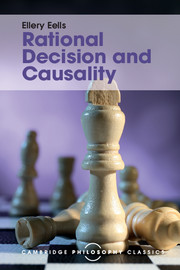Book contents
- Frontmatter
- Dedication
- Contents
- Preface to this edition
- Preface
- Introduction
- 1 Bayesianism
- 2 The philosophical and psychological significance of Bayesian
- 3 Bayesian decision theories: some details
- 4 The counterexamples
- 5 Causal decision theories
- 6 Common causes, reasons and symptomatic acts
- 7 A general defense of PMCEU
- 8 Newcomb's paradox
- Appendix 1 Logic
- Appendix 2 Probability
- Bibliography
- Index
3 - Bayesian decision theories: some details
Published online by Cambridge University Press: 05 July 2016
- Frontmatter
- Dedication
- Contents
- Preface to this edition
- Preface
- Introduction
- 1 Bayesianism
- 2 The philosophical and psychological significance of Bayesian
- 3 Bayesian decision theories: some details
- 4 The counterexamples
- 5 Causal decision theories
- 6 Common causes, reasons and symptomatic acts
- 7 A general defense of PMCEU
- 8 Newcomb's paradox
- Appendix 1 Logic
- Appendix 2 Probability
- Bibliography
- Index
Summary
In this chapter, the basic elements of three developments of Bayesian decision theory will be presented: the theories of Ramsey's, Savage's and Jeffrey's. (Since the subsequent chapters will focus on Jeffrey's theory, some readers may wish to concentrate only on the third section of this chapter.) Not all the details will be given, and the discussion will be, for the most part, informal. However, sufficient detail will be given to make possible a discussion of the relative merits of the three theories. The two main problems to which the theories provide different answers are: (i) What are the entities to which the agent's subjective probabilities and desirabilities attach? And (ii) How are these subjective probabilities and desirabilities measured? The points of comparison among the three theories on which this chapter will focus involve the nature of the basic entities assumed by the theories and how they enter into the calculation of subjective expected utility.
Ramsey
In his essay, ‘Truth and Probability’ (1926), Ramsey is primarily concerned with the problem of defining ‘degree of belief’, and he suggests a method of measuring an agent's subjective probabilities and desirabilities from his preferences. The basic entities in Ramsey's theory are: outcomes, propositions, gambles and a preference relation on the set of outcomes and gambles. Ramsey calls the outcomes ‘possible worlds’; so the outcomes should be thought of as maximally specific relative to the set of eventualities which the agent considers to be relevant to his happiness. They are “the different totalities of events between which our subject chooses – the ultimate organic unities” (1926: 176–7, my italics). Gambles are constructed from outcomes and propositions. A gamble is an arrangement under which the agent gets some specified outcome if a given proposition is true and another specified outcome if the proposition is false. I will symbolize gambles according to the following pattern: ‘[Oi, p, Oj]’ denotes the gamble: The agent gets outcome Oi if proposition p is true and outcome Oj if p is false. Note that a gamble [Oi, p, Oj] is the same as [Oj, –p, Oi]. Also note that, as pointed out earlier, outcomes can be thought of as gambles of a kind: an outcome Oi can be thought of as the gamble [Oi, p, Oi], or [Oi, p ˅ –p, Oj].
- Type
- Chapter
- Information
- Rational Decision and Causality , pp. 59 - 78Publisher: Cambridge University PressPrint publication year: 2016



